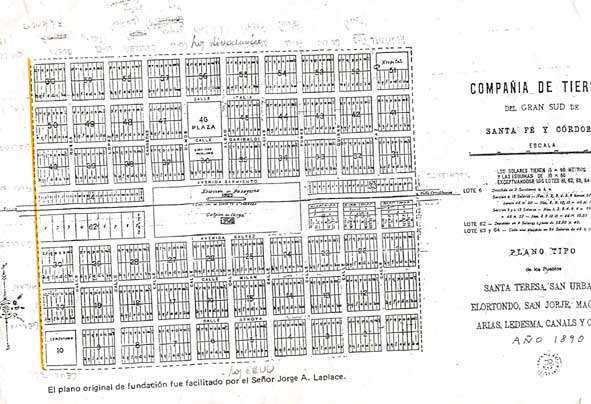
| In
the Name of Power Page 4 |
|||||||||||||||||||||||||||||||||||||||
A
new change of street names followed the same strategy. Venado Tuerto,
together with other cities of the country, took part in the preparation
for the commemoration. Eleven months in advance, there was a meeting
at the London Hotel to create a special committee for the Centenary
celebrations. [14] The Centenary Committee worked together with
the Funding Committee, which was in charge of the financial administration
of the town. The Funding Committee appointed members of the Centenary
Committee. To illustrate the particular ideological atmosphere of
the time, the resignation to the Committee Chair by one neighbour,
Luis Cucchiani, was based on his foreign origins. Cucchiani recommended
to appoint an Argentine citizen and, at the same time, reaffirmed
his support for the celebration.
The
Centenary Committee aligned the celebrations with the government
interests and strategy, and therefore changed the toponymy of the
city. The old names were replaced by the names of heroes, who were
considered the central characters of the Independence. The street
names changed abruptly, representing a successful and subtle political
operation, the target of which was to shape the idea of an Argentine
Nation and its people. Four days before the Centenary the street
name change was formalised and submitted by the Centenary Committee
Chair, Manuel Sosa, to the President of the Funding Committee, Patricio
Kirk. [15] |
|||||||||||||||||||||||||||||||||||||||
|
The change of street names supported the creation of a patriotic feeling towards Argentina. The transformation was performed with the participation of local political authorities. Additionally, this process of patriotic development received support from Santa Fe provincial authorities. From a total of forty streets, only six kept their name. Four plazas changed their name too. Thirty-four streets names related to national heroes, dates, and battles. The historic events taken into account by the new toponymy were the May 1810 Revolution, the Declaration of Independence, and other dates connected to the development of the national state. The local leaders, with the exception of Brigadier López, were neglected and names connected to European immigration or patria gringa were forgotten too. Street names like Casey and Runciman, founders of Venado Tuerto, were displaced from the centre to the suburbs. Other streets received the names of neighbouring countries (Uruguay), of other countries strongly related to Argentina (Spain, England), of Argentine provinces (Buenos Aires, Tucumán), or the name of the great European conquistador, Colón. The street naming strategy of 1910 in Venado Tuerto was an outcome of the Argentine elite's scheme to manipulate the May Revolution with the idea of imagining the concept of Argentineness. And
the Action Continued |
|||||||||||||||||||||||||||||||||||||||
|
|||||||||||||||||||||||||||||||||||||||
| Please contact us if you have a question or wish to suggest changes |
Copyright © The Irish Argentine Historical Society. 2004 |

